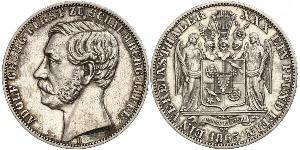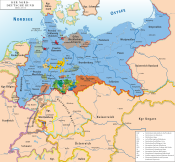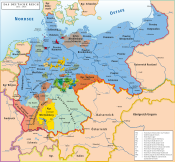| preceded by | |
|
|||||||||
|
|
|||||||||
| succeeded by |
| Principality of Schaumburg-Lippe (1643 - 1918)from the Wikipedia | Read original article |
| County (Principality) of Schaumburg-Lippe | ||||||
| Grafschaft (Fürstentum) Schaumburg-Lippe | ||||||
| State of the Holy Roman Empire State of the Confederation of the Rhine State of the German Confederation State of the North German Confederation State of the German Empire |
||||||
|
||||||
|
||||||
| Anthem Heil unserm Fürsten, heil Hail to our Prince, hail! |
||||||
|
Schaumburg-Lippe within the German Empire
|
||||||
| Capital | Bückeburg | |||||
| Government | Principality | |||||
| Historical era | Early modern Europe | |||||
| • | Partitioned from Schaumburg |
1643 1643 |
||||
| • | Inherited Lippe-Alverdissen |
1777 |
||||
| • | Raised to principality | 1807 | ||||
| • | German Revolution | 1918 | ||||
| • | Merged into Lower Saxony |
1946 |
||||
| Area | ||||||
| • | 1905 | 340 km² (131 sq mi) | ||||
| Population | ||||||
| • | 1905 est. | 44,992 | ||||
| Density | 132.3 /km² (342.7 /sq mi) | |||||
Schaumburg-Lippe was created as a county in 1647, became a principality in 1807, a free state in 1918, and was until 1946 a small state in Germany, located in the present day state of Lower Saxony, with its capital at Bückeburg.
Contents
History[edit]
Schaumburg-Lippe was formed as a county in 1647 through the division of the County of Schaumburg by treaties between the Duke of Brunswick-Lüneburg, the Landgrave of Hesse-Kassel and the Count of Lippe. The division occurred because Count Otto V of Holstein-Schaumburg had died in 1640 leaving no male heir. Initially Schaumburg-Lippe's position was somewhat precarious: it had to share a wide variety of institutions and facilities with the County of Schaumburg (which belonged to Hesse-Kassel), including the representative assembly and the highly productive Bückeberg mines, and the Landgrave of Hesse-Kassel retained some feudal rights over it. It was further threatened by the headstrong policies of ruling Count Friedrich Christian. To counter these threats, Friedrich's grandson Count Wilhelm (who reigned 1748–1777) retained a standing army of up to 1000 troops - quite a lot for such a small territory.
With Wilhelm's death in 1777 the junior Schaumburg-Lippe-Alverdissen inherited the County thereby reuniting Schaumburg-Lippe with Lippe-Alverdissen.
Schaumburg-Lippe was a county until 1807 when it became a principality; from 1871 it was a state within the German Empire. In 1913, it was the smallest state in the German Empire in terms of population.[1] The capital was Bückeburg, and Stadthagen was the only other town. Under the constitution of 1868, there was a legislative diet of 15 members, 10 elected by the towns and rural districts and 1 each by the nobility, clergy and educated classes, the remaining 2 nominated by the prince. Schaumburg-Lippe sent one member to the Bundesrat (federal council) and one deputy to the Reichstag.[2] It lasted until the end of the German monarchies in 1918, when it became a free state as the Free State of Schaumburg-Lippe. In November 1918, Prince Adolf was the second last reigning German monarch to abdicate.
Rulers of Schaumburg-Lippe[edit]

Counts of Schaumburg-Lippe (1643–1807)[edit]
- Philip I (1643–81)
- Frederick Christian (1681–1728)
- Albert Wolfgang (1728–48)
- William (1748–77)
- Philip II Ernest (1777–87)
- George William (1787–1807)
Princes of Schaumburg-Lippe (1807–1918)[edit]
- George William (1807–60)
- Adolf I (1860–93)
- George (1893–1911)
- Adolf II (1911–18)
Heads of the House of Schaumburg-Lippe, post monarchy[edit]
- Adolf II (1918–36)
- Wolrad (1936–62)
- Philipp-Ernst (1962–2003)
- Alexander (2003–present)
Heir: Hereditary Prince Heinrich-Donatus (born 1994)
See also[edit]
| Wikimedia Commons has media related to Schaumburg-Lippe. |
References[edit]
- ^
 "Schaumburg-Lippe". Catholic Encyclopedia. New York: Robert Appleton Company. 1913.
"Schaumburg-Lippe". Catholic Encyclopedia. New York: Robert Appleton Company. 1913. - ^
 Chisholm, Hugh, ed. (1911). "Schaumburg-Lippe". Encyclopædia Britannica (11th ed.). Cambridge University Press.
Chisholm, Hugh, ed. (1911). "Schaumburg-Lippe". Encyclopædia Britannica (11th ed.). Cambridge University Press.
|
|||||||||||||||||||||||||||||||||||||||
|
|||||||||||||||||||||||||||||||||||||||||||||||||||
|
|||||||||||||||||||||||||||||||||||||||||
|
||||||||||||||||||||||||
|
||||||||||||||||||||||||||||||||
- Former principalities
- Former countries in Europe
- States of the Holy Roman Empire
- States and territories established in 1643
- States and territories disestablished in 1918
- States of the Confederation of the Rhine
- States of the German Confederation
- States of the North German Confederation
- States of the German Empire
- Former states and territories of Lower Saxony













